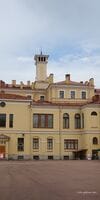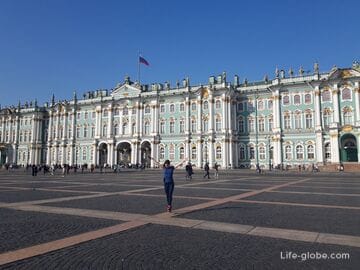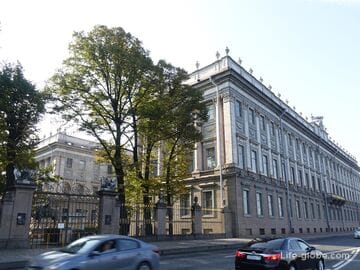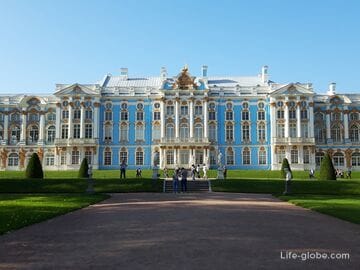The Yusupov Palace on the Moika (Yusupov Palace on the Moika) is a former noble manor (palace), as well as a monument of history and culture, which is a significant landmark of St. Petersburg.
The Yusupov Palace is an architectural ensemble of the 18th and 20th centuries, consisting of a palace with a front yard, former wings, a garden pavilion, an inner courtyard and a garden.
Today, the Yusupov Palace is a museum. The halls, living rooms and other rooms of the palace can be visited for a fee on their own or with a guide. Thematic excursions, exhibitions, concerts, performances, various programs and events are also held in the premises of the former estate.
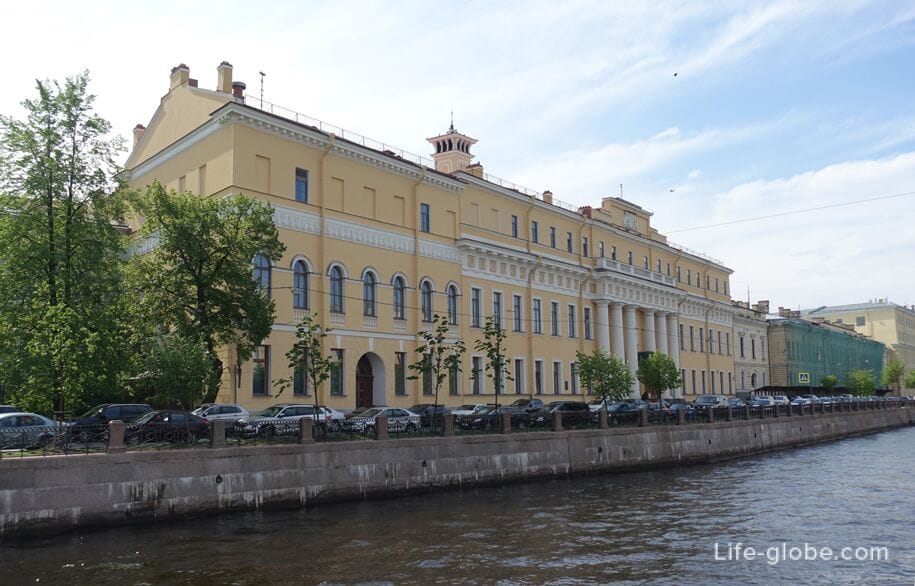
The beginning of the formation of the palace dates back to the time of Peter the Great, when the estate of the niece of Per I, Princess Praskovya Ioannovna, was located on this site. In 1726, Praskovya Ioannovna, having lost the favor of Peter the Great, donated a plot of land with a stone house of the Life Guards to the Semenovsky regiment.
In the mid-1740s, the estate was sold to Peter Ivanovich Shuvalov and his wife, the lady-in-waiting of Empress Elizabeth Petrovna (therefore, the Yusupov Palace is also known as the Shuvalov mansion). The manor was rebuilt. After the death of P.I. Shuvalov, the estate passed to his son Andrey Petrovich Shuvalov, under whom the estate acquired the final boundaries, and the famous French architect J.B.M. Vallin-Delamot was invited to build a large ceremonial palace.
In 1789, Count A.P. Shuvalov died, and the heirs sold the property to the treasury.
In 1795, Empress Catherine II granted the estate to her stateswoman and close friend Countess Alexandra Vasilyevna Branitskaya "for eternal and hereditary possession." In 1830, Branitskaya ceded the estate to her younger sister, Princess Tatyana Vasilyevna Yusupova. This was the beginning of the Yusupov history of the Moika Palace.
The new owners planned to live in the estate year-round and launched large-scale work on the reorganization of the estate space, inviting the famous St. Petersburg architect A.A. Mikhailov 2nd. The palace building was built over and halls were created, outbuildings were built, including: a laundry room, which also had an ironing room, a stable with stalls for 15 horses, a garden, two-story houses for servants, a carriage house, glazed greenhouses, improvised refrigerator - glaciers, and other office and utilitarian buildings. The estate also included a park with a low Parnassus hill, marble sculptures, gazebos and benches.
Until 1917, the palace was owned by five generations of the Yusupov princes; after that, the palace was nationalized. On the night of December 17 (New Style 30), 1916, the favorite of the imperial family, Grigory Rasputin, was killed in the palace. The exhibition "The Murder of G. Rasputin" is now open in the basement where the events unfolded.
During the Great Patriotic War, the Yusupov Palace suffered. Subsequently, the estate was restored and today the complex of the Yusupov Palace works as a museum and a venue for various events.
The complex of the Yusupov Palace on Moika occupies a section from the Moika River Embankment, 94 to Dekabristov Street, 21. Entrance for individual visitors from Dekabristov Street.
The front facade of the palace, which has a classic architectural appearance, overlooks the Sink.
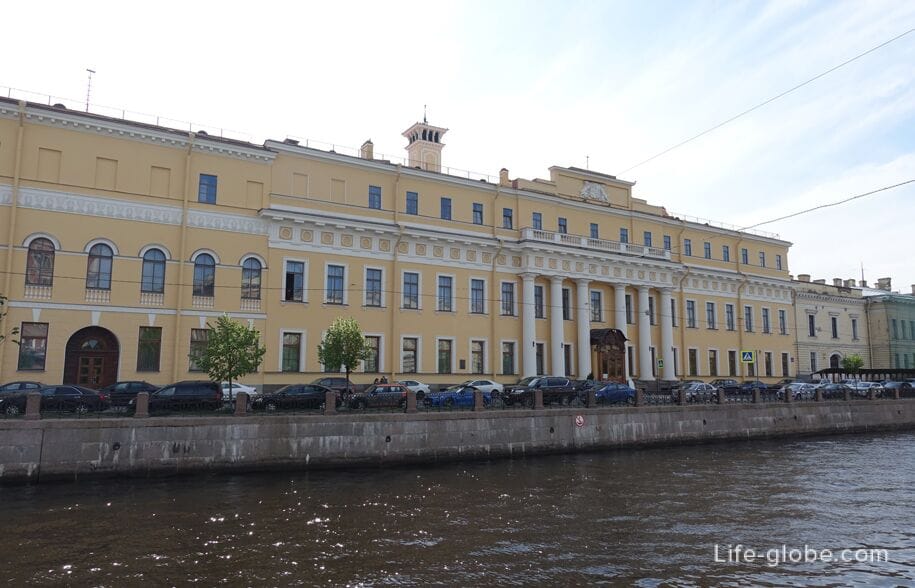

On the side of Dekabristov Street there is a courtyard and a ticket office with a small cafe.
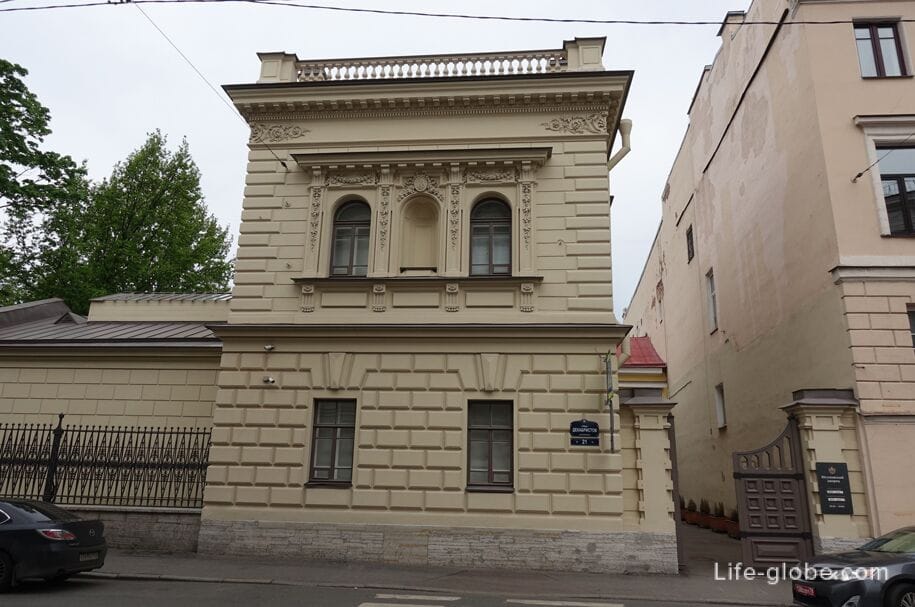
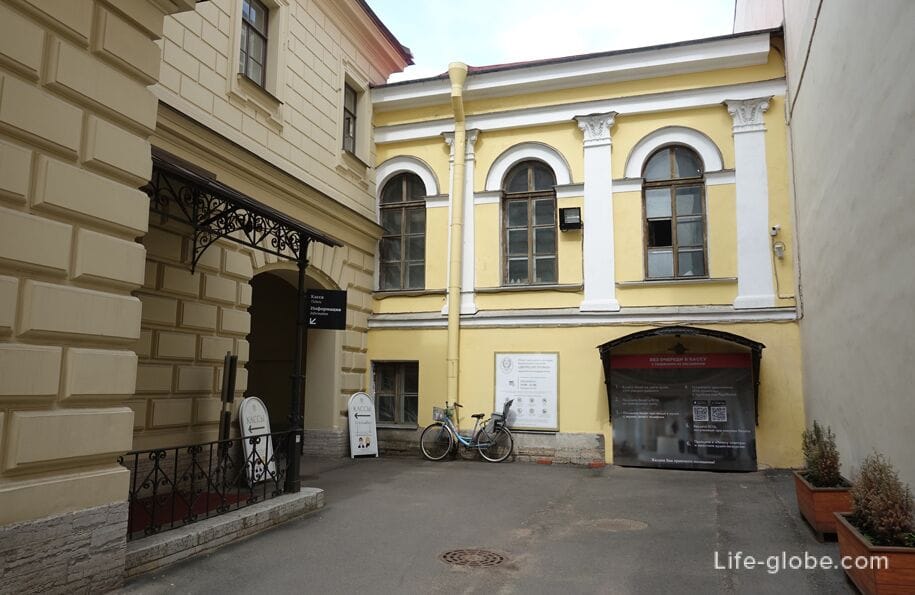
Through the courtyard you can go to the garden of the Yusupov Palace. Entrance to the garden is free (free of charge).
In the garden: Parnassus slide with stone steps (landscape slide), places to relax (garden benches), flower and shrub groups, electric lights imitating gas.
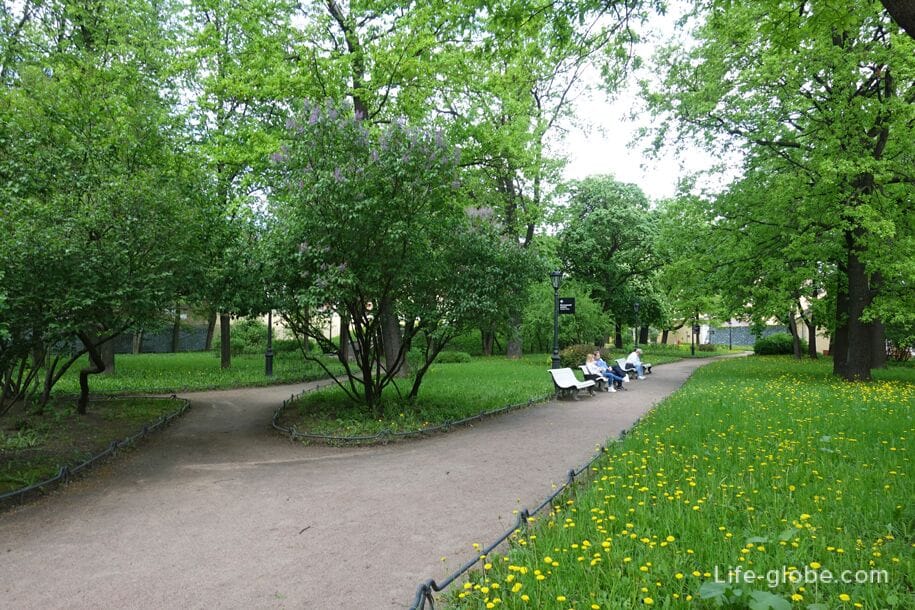

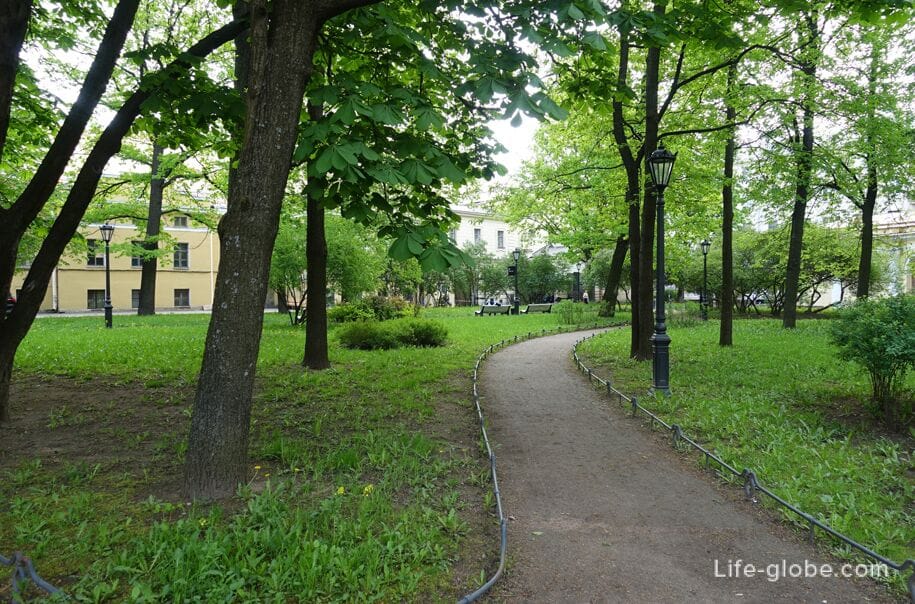
The border of the garden from Dekabristov Street is decorated with a cast iron lattice, into which the Garden Pavilion is inscribed.

On the east side, the garden is surrounded by former service wings: the palace, the laundry and the stable, where temporary exhibitions and events of various scales are held.
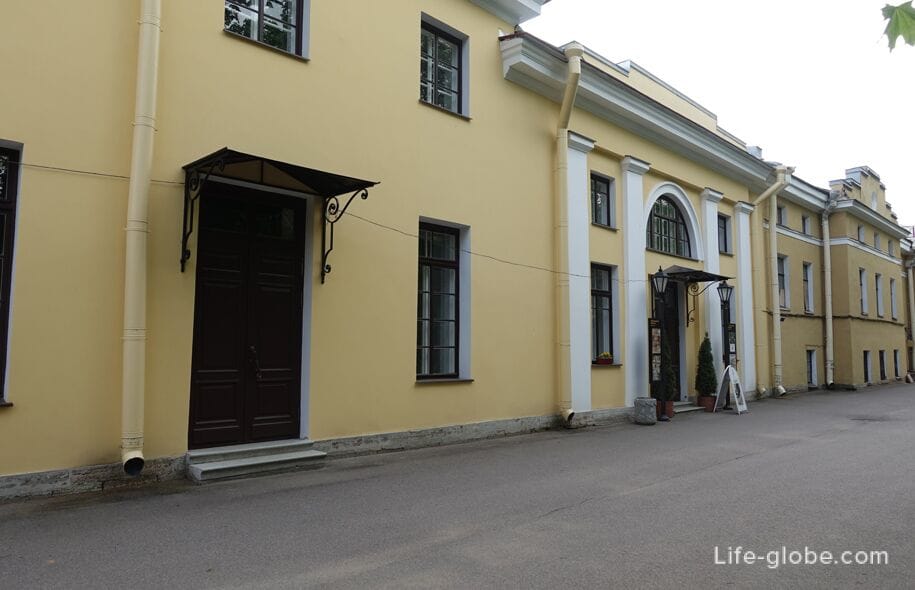
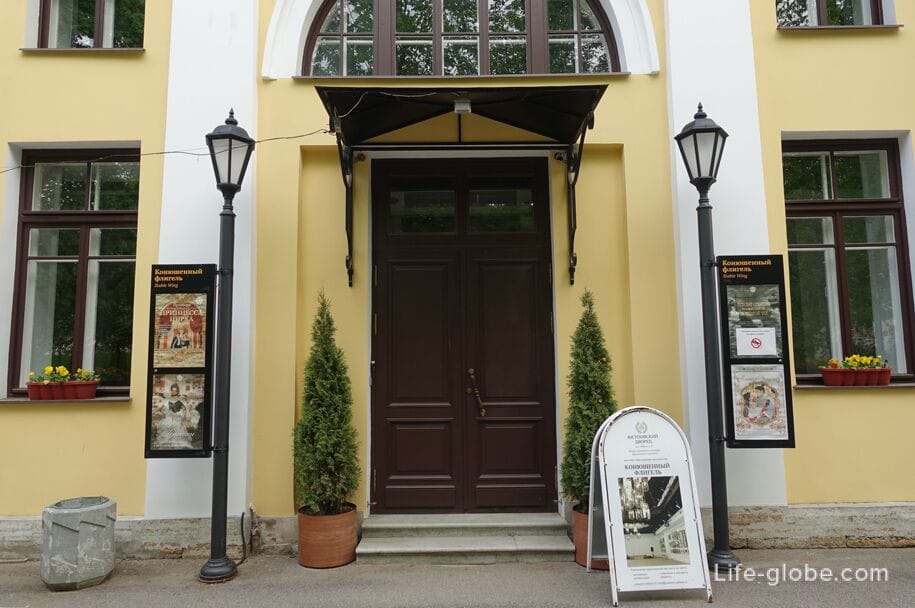
The Yusupov Palace itself, which is called the Ceremonial Palace, is separated from the park and wings by a stone fence (architect Vallen Delamot) with three gates: the central gate, the western gate and the eastern gate (the entrance to the former kitchens of the Yusupov Palace).
Photo of the Central Gate

Photo of the West Gate
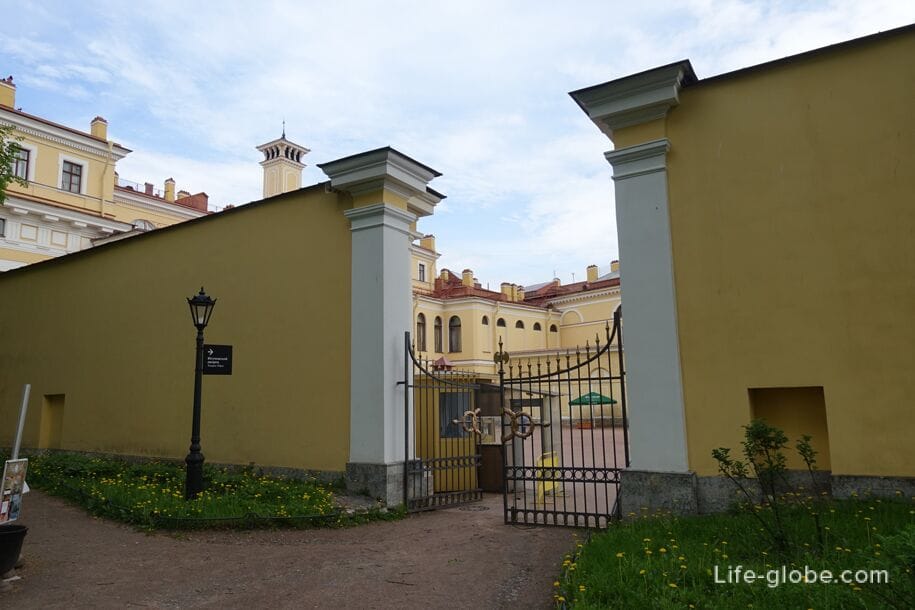
The entrance for individual visitors to the palace is through the western gate.
The gate leads to a small Grand courtyard of the palace, which is framed on one side by a colonnade, and on the other it is decorated by the Yusupov Palace itself.
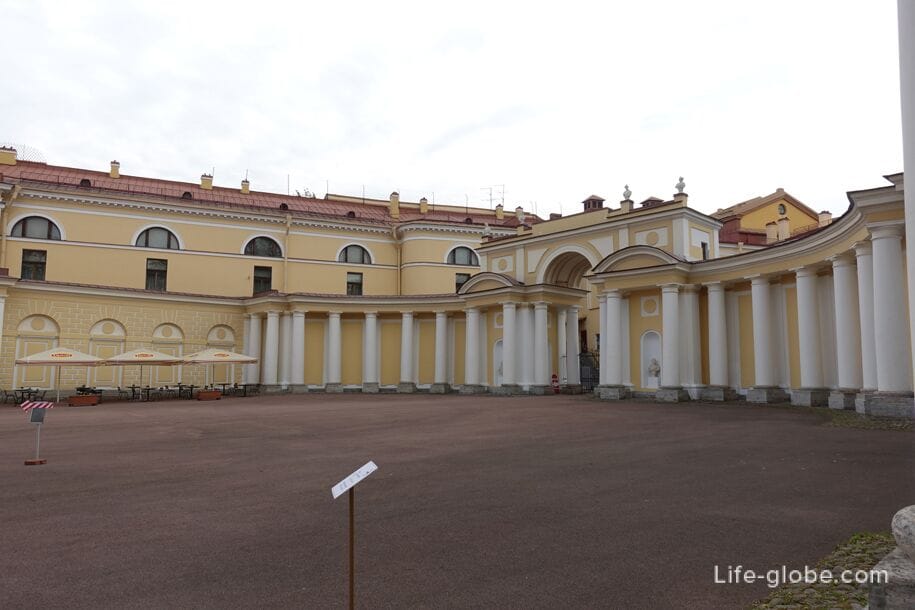
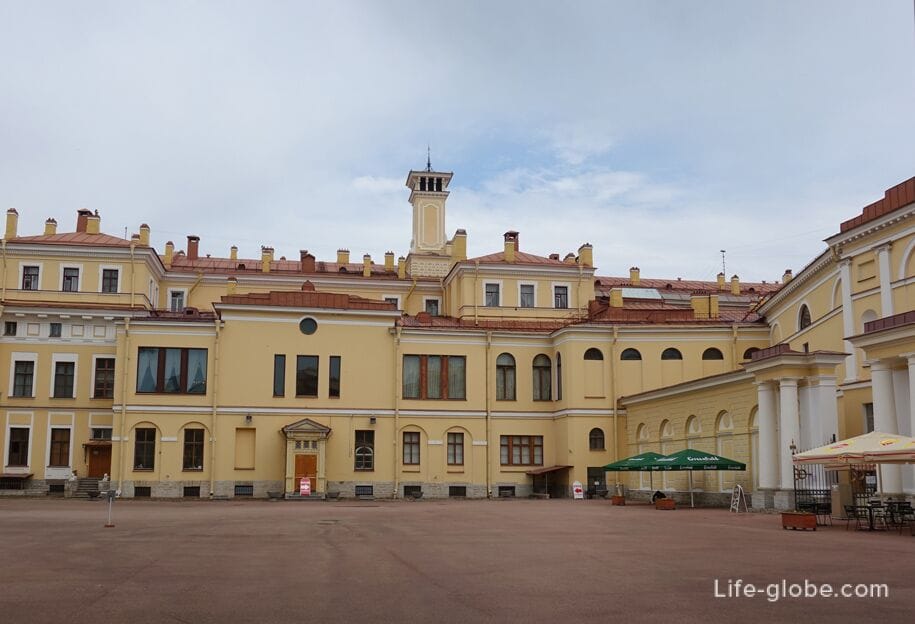
Visit to the Yusupov Palace
Today the palace is open to the public. Within its walls there are restored halls, including state rooms, living rooms, an art gallery, the living quarters of the prince and princess, a home theater, a house church and the exhibition "The Murder of G. Rasputin".
Various routes of excursion programs (with a mobile application or audio guide) pass through the halls and rooms of the palace, with each of which you can visit certain palace premises and the exhibition "The Murder of G. Rasputin". There are two routes for self-inspection of the palace: "The Grand Halls and the Prince's Living Quarters" and "The murder of G. Rasputin and Half of the young".
Thematic tours are also conducted around the Yusupov Palace with visits to the halls and premises of the palace.
We recommend that you check all the current routes, costs and conditions of visiting the palace on the official website (the site is indicated at the end of this article).
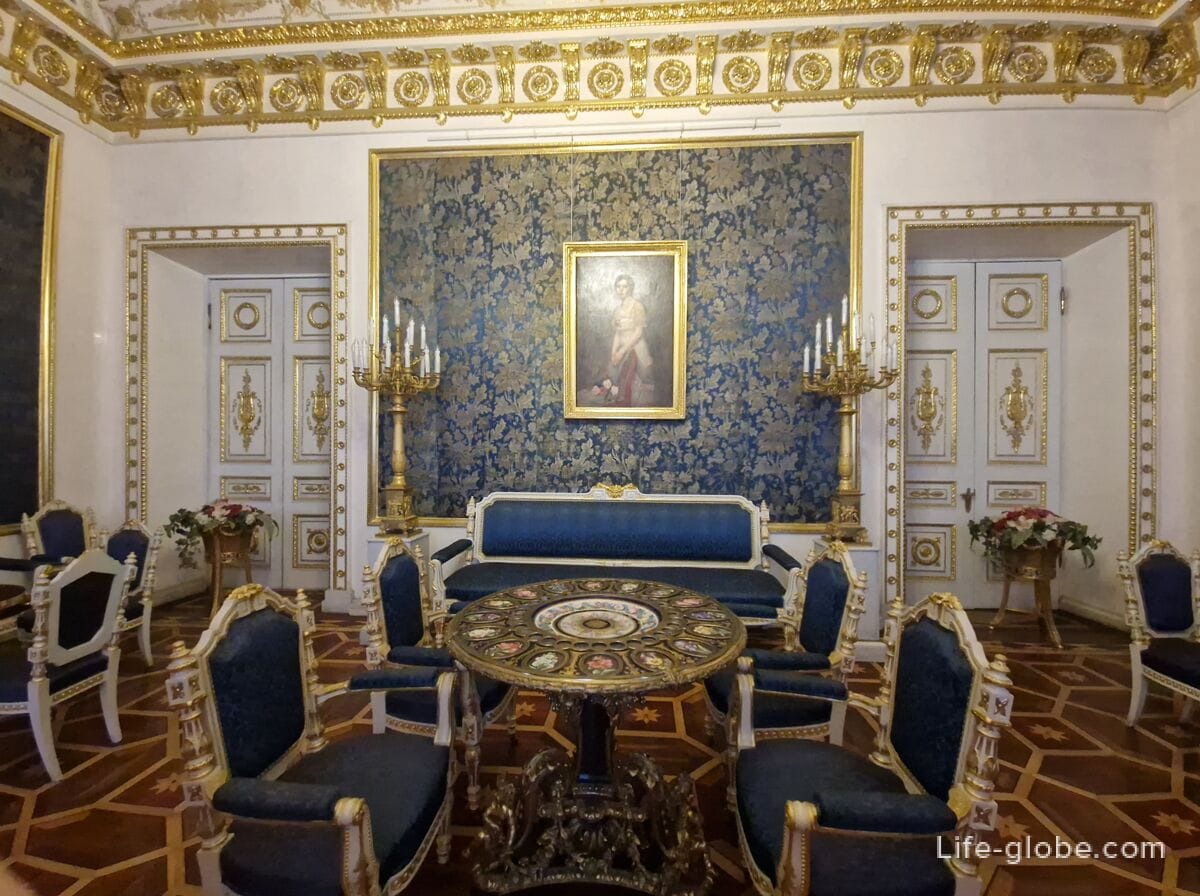
Halls of the Yusupov Palace
The main halls of the palace
The regally luxurious living rooms and spacious palace halls were once designed for ceremonial routs, large balls and high-society receptions, for which the Yusupov aristocrats were famous.
The architecture and decoration of the Yusupov Palace presents almost all the artistic styles that were popular in the design of the palace interiors of the 19th century.
The suite of state rooms and living rooms is designed in the style of the solemn Empire style: gilding, marble, picturesque plafonds, parquet floors, porcelain, openwork bronze, gold-woven silks, crystal and Venetian mirrors. All this is complemented by chic furniture, exquisite interior and household items.
The state rooms are located on the 2nd floor of the Yusupov Palace and include: The Grand Staircase, the Tapestry living room, the Princess's Bedroom (Front Bedroom), the Large and Small Rotunda, living rooms, Dance and Banquet halls, halls of the Art Gallery, the Antonio Viga Hall, the Coronation Corridor and the Oak Dining Room.

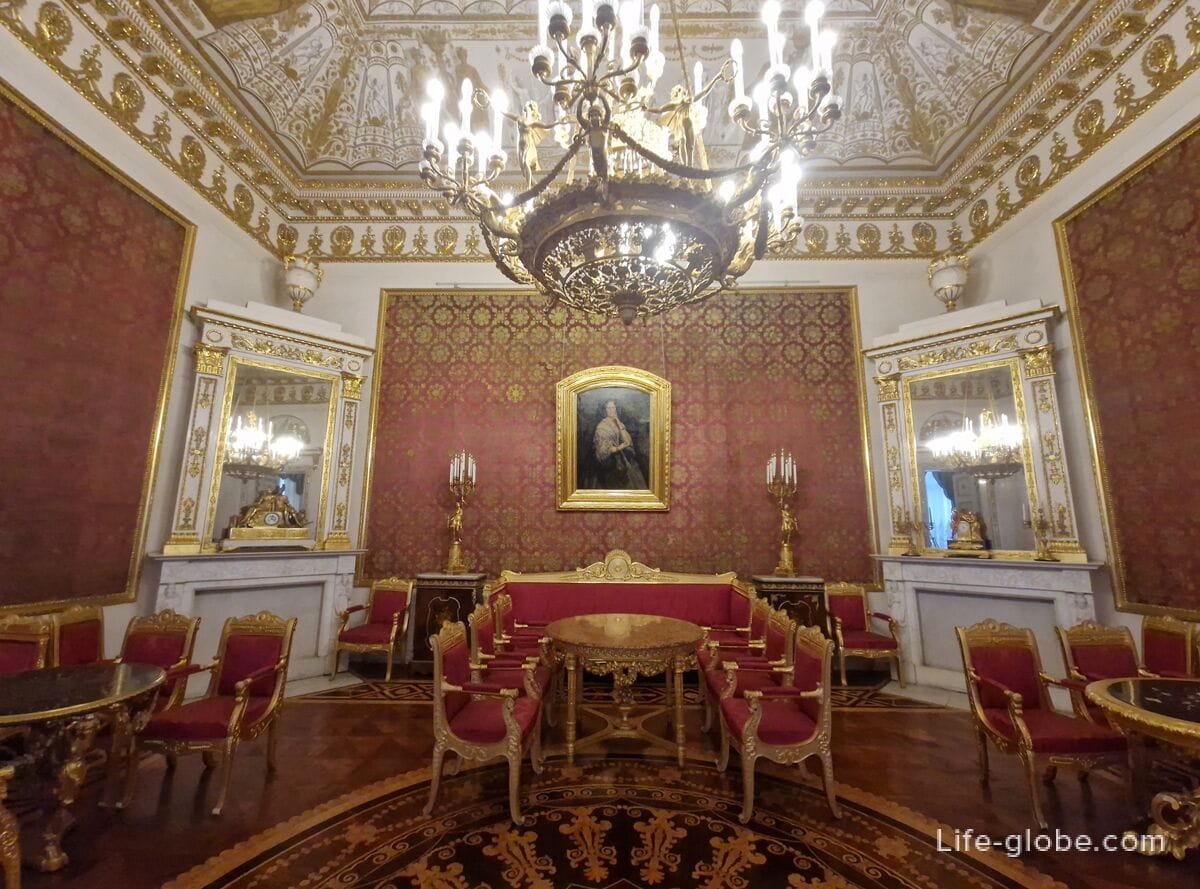

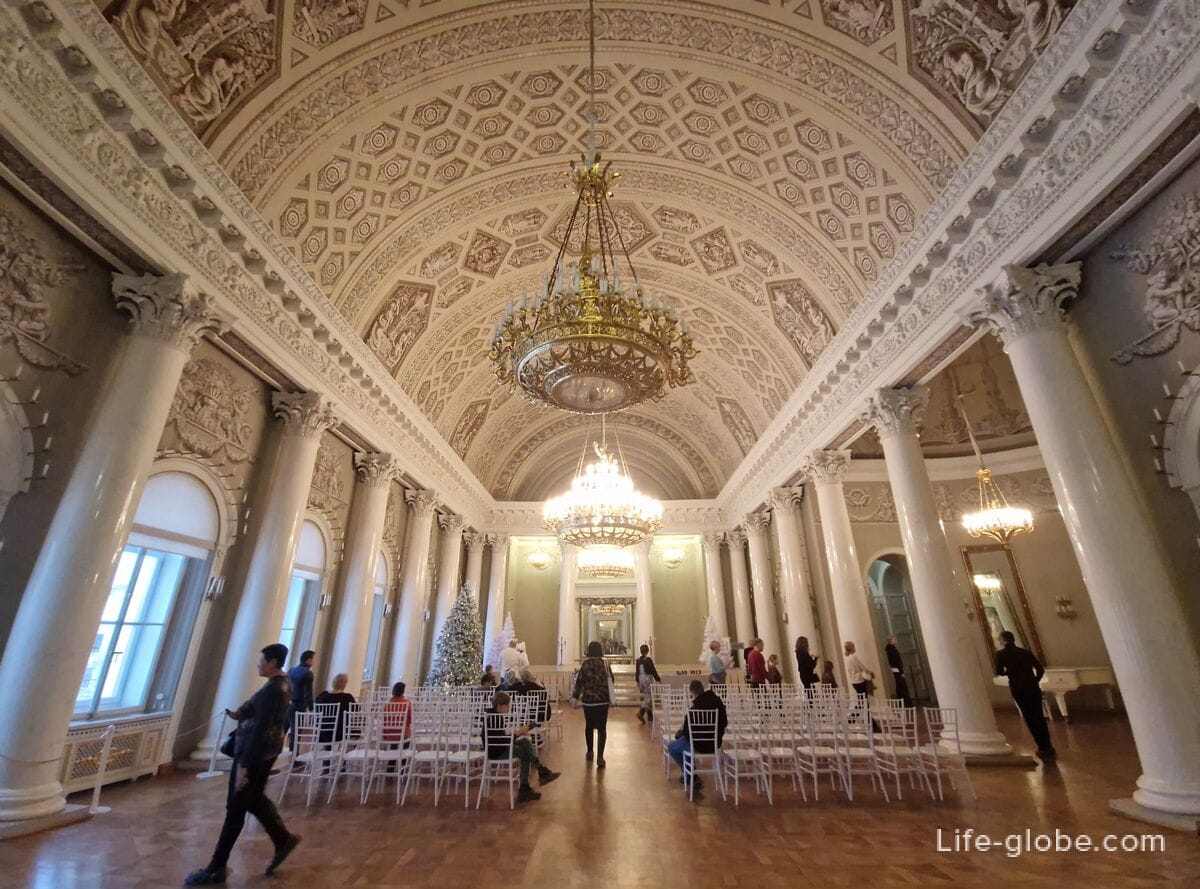
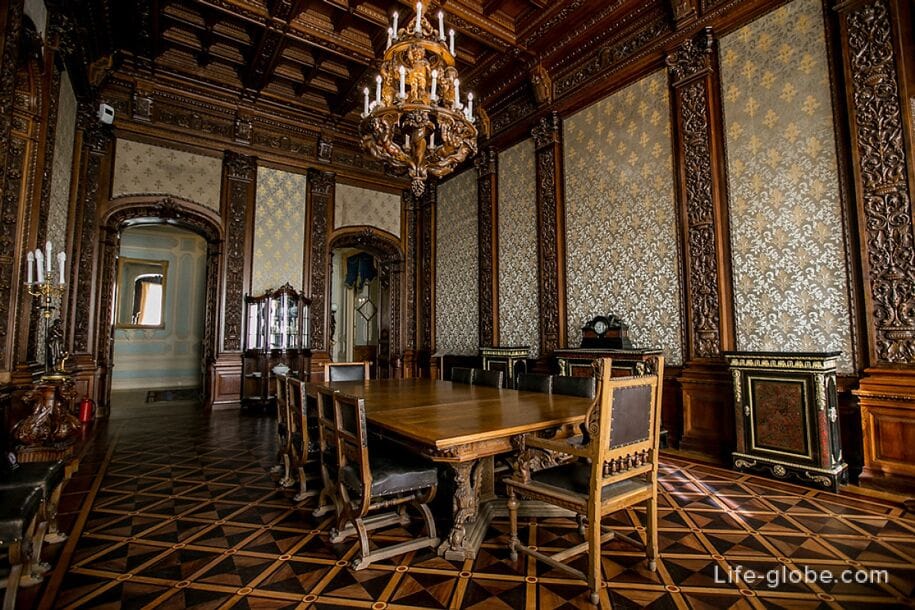
The Prince's living quarters
The male residential half of the palace (or the prince's chambers) is located on the ground floor in the western part of the palace.
The premises here have preserved the layout and decoration of the second half of the 19th century, which were held for Prince Nikolai Borisovich Yusupov Jr.
Among the interiors: A musical living room with stucco and gilt highlights, Henry II's Living room with pear wood trim, the Prince's Study with a library, a Turkish study (billiard room), the design of which was inspired by the images of Ottoman sofa rooms, a dressing room, a Secretary's room, the Prince's Dining Room (Buffet) and one of the most famous and unsurpassed in its artistic the splendor of the interiors is a Moorish living room.
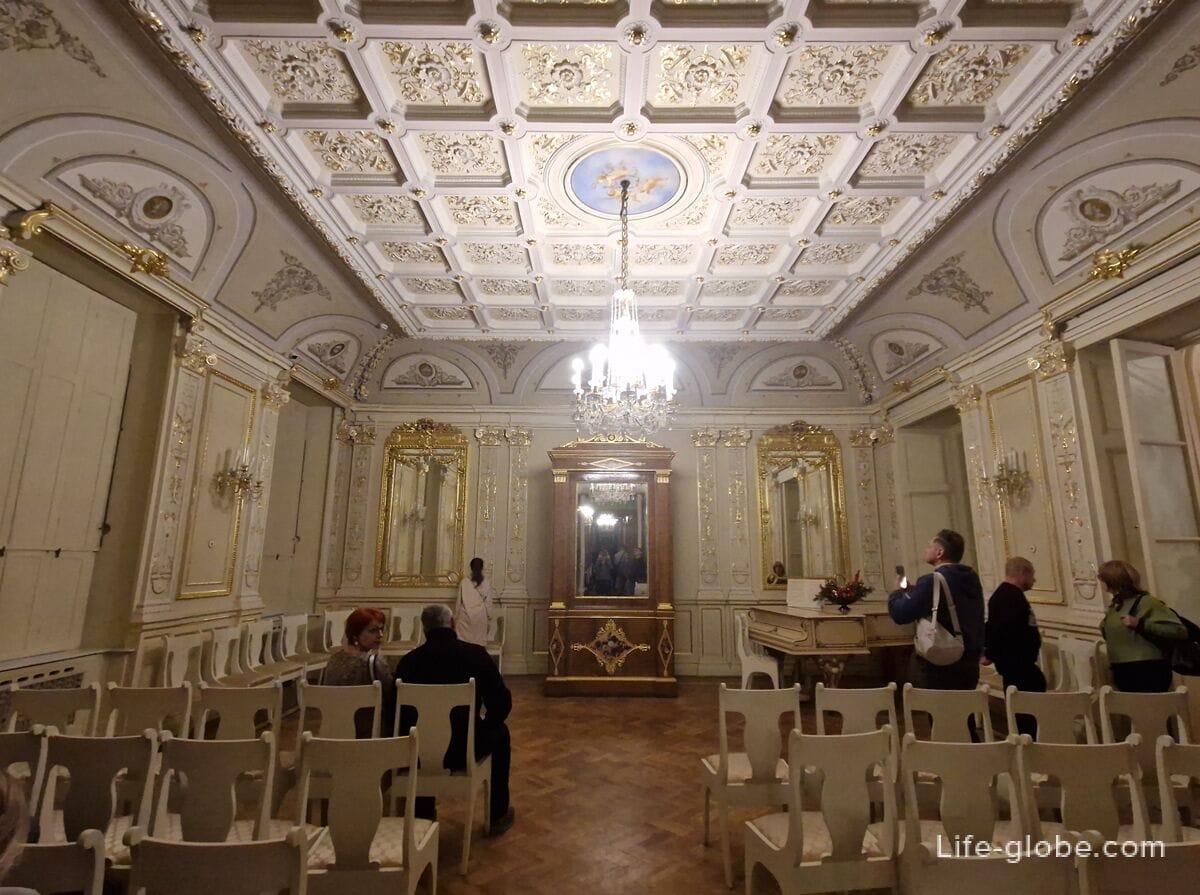
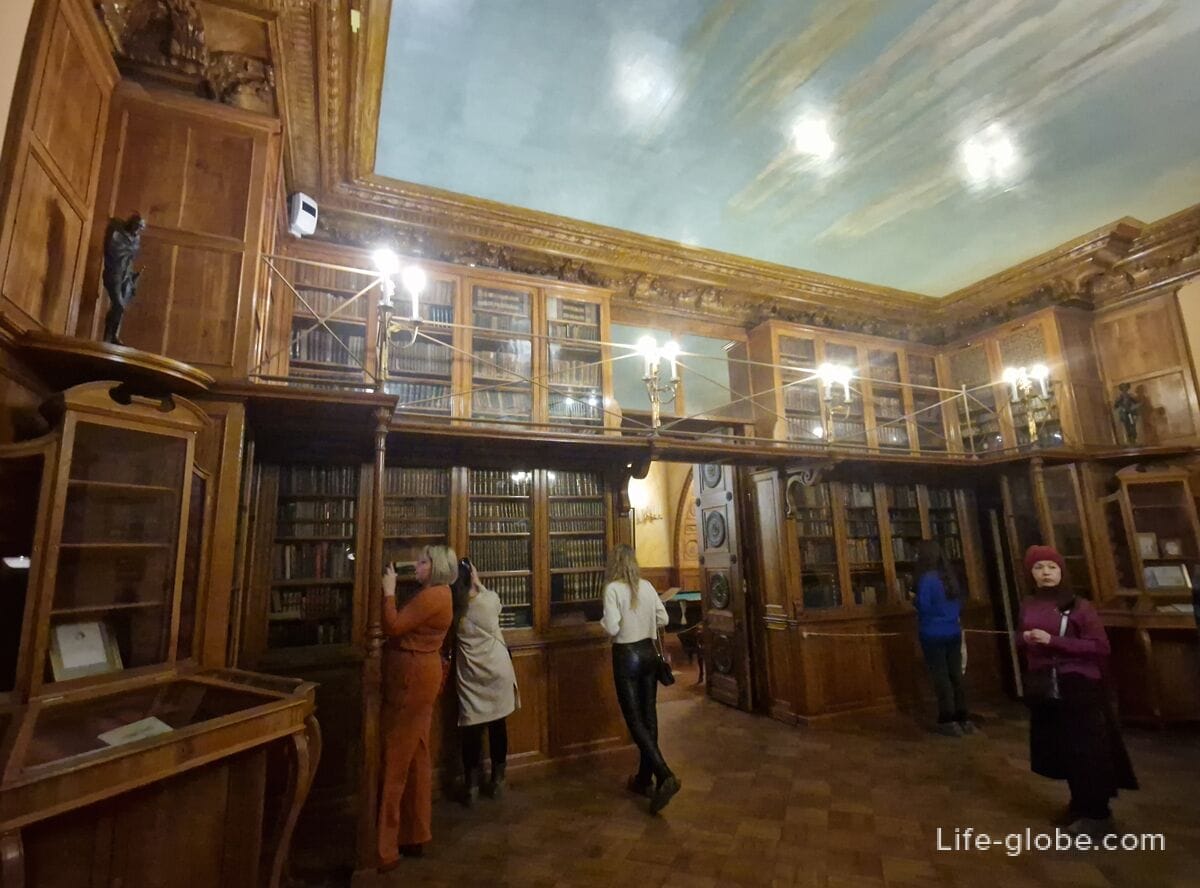
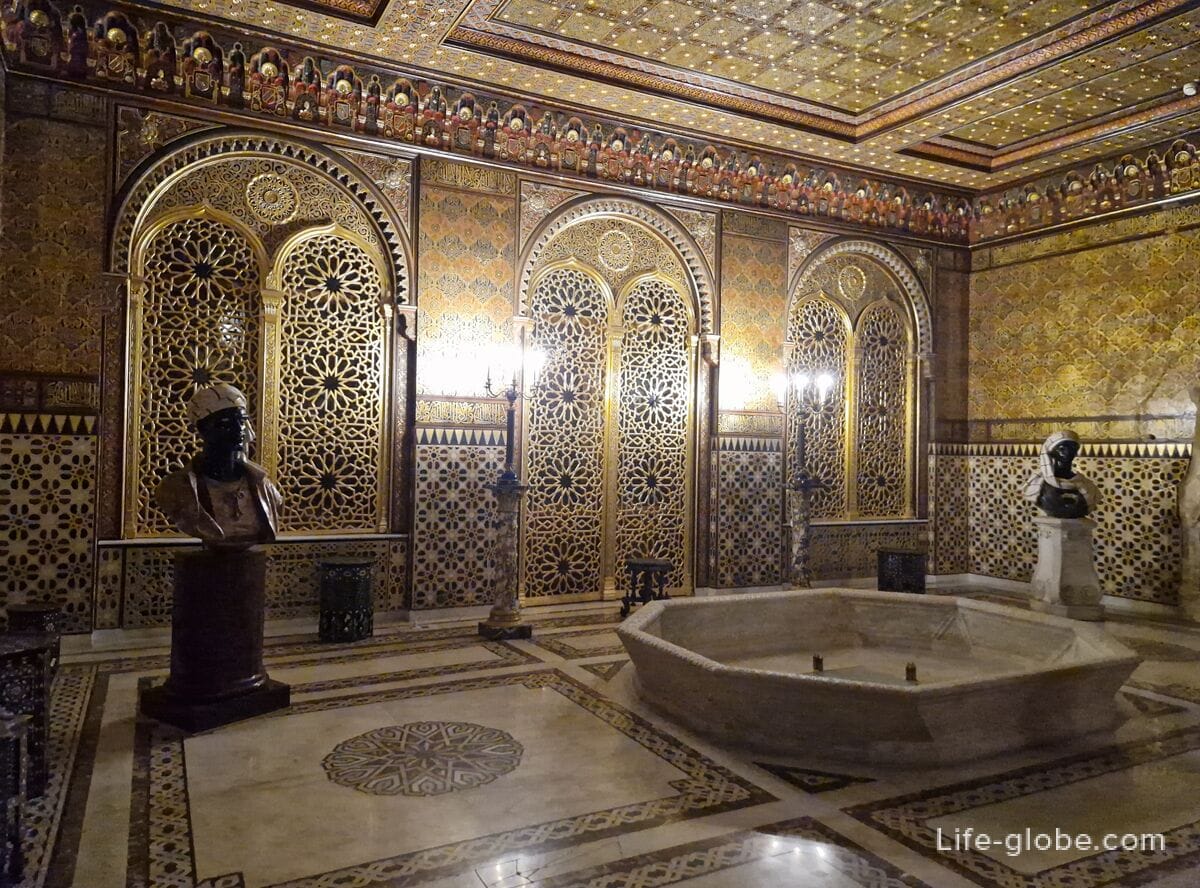
In the Music Room there is a mechanical organ - one of the most perfect instruments that have survived to our time, which appeared in the princely house back in the 40s of the 19th century. The completeness of the instrument has been preserved - all 9 shafts on which the works of composers D. Rossini, D. Aubert, G. Spontini and others were recorded at that time.
The sound of the instrument can be heard at musical evenings held in the palace.
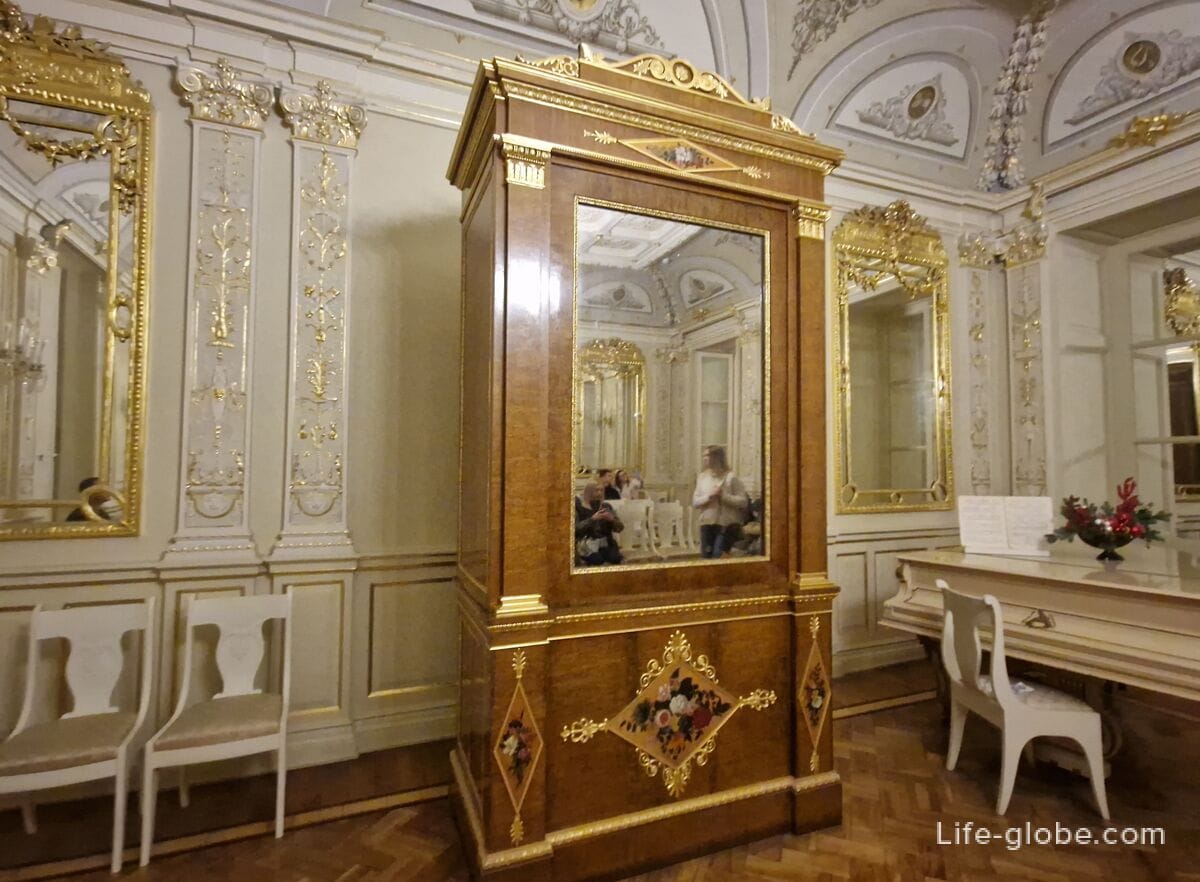
Yusupov Palace Theatre
The miniature Home Theater of Yusupovsky with its interior resembles a box, decorated in imitation of the Rococo style.
The architectural and decorative decoration of the auditorium includes: stucco ornaments of rocaille shape, flowing smooth lines of finishing elements, an abundance of gilding, bright colors of the ceiling painting and paintings on the barriers of the tiers and in the side boxes.
A special place in the theater hall is occupied by a large central box, crowned with a princely crown and a monogram of Zinaida Nikolaevna Yusupova.
The theater is active. Its stage hosts productions of classical operas and sparkling operettas, fragments of Russian ballets, performances and theatrical performances. Learn more about the Yusupov Palace Home Theater...
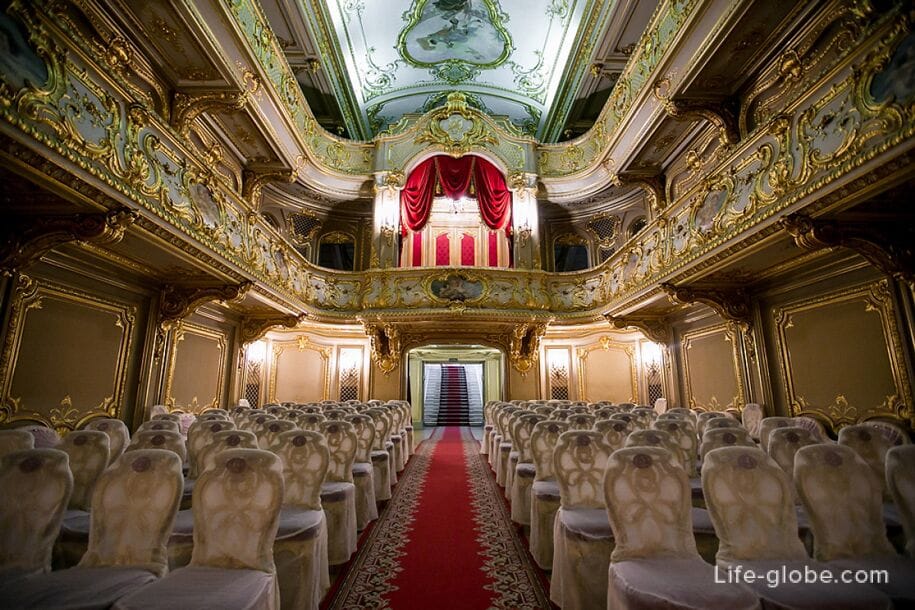
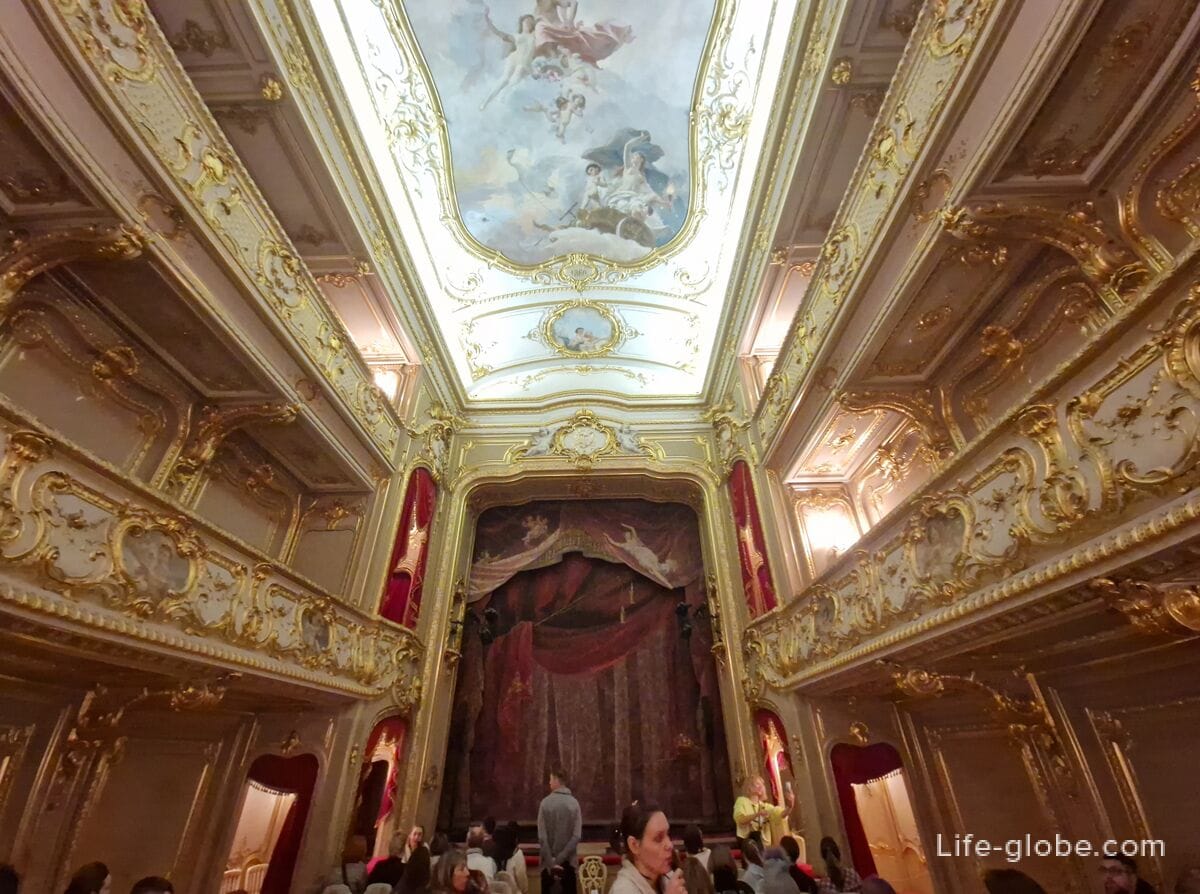
Remark! All of the above interiors of the Yusupov Palace can be viewed as part of excursions around the palace and when visiting the route "State Halls and Living Quarters of the Prince", which is suitable for an individual self-visit with an audio guide or a mobile application.
The house church of the Yusupov Palace
On the third floor of the Yusupov princely house there was a House Church, which was arranged and decorated according to the project of Academician of architecture V.A. Kenel, consecrated in March 1881 and operated until 1917.
In this church (according to the traditions of that time), all the significant events of the Yusupov family took place, including: on April 4, 1882, Princess Zinaida Nikolaevna Yusupova and Count Felix Felixovich Sumarokov-Elston were married; five years later, their youngest son Felix was baptized; in 1908, the 25-year-old elder Nikolai was buried; and in 1915 Emperor Nicholas II attended the baptism of Irina, the daughter of Felix Yusupov, together with his mother, the Dowager Empress Maria Feodorovna.
In 1926, the church ceased to exist, and in the 1930s it was completely dismantled and turned into a lecture hall.
Now the interior of the church has been recreated.
The church can be visited with tours of the palace.
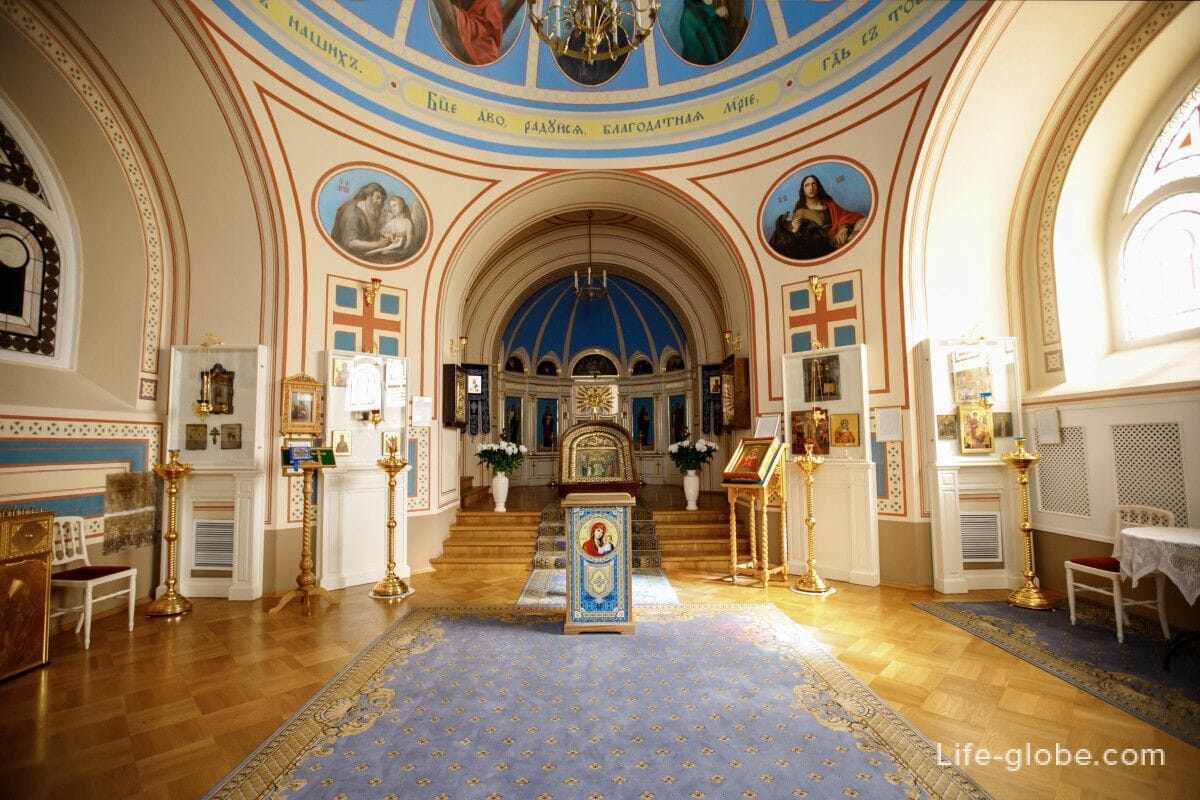
The Princess's chambers
The private chambers of Princess Zinaida Nikolaevna Yusupova, which are referred to as the Boudoirs of the Princess, are a complex of interiors on the 2nd floor of the palace, which the Princess used every day.
The Princess's chambers include such rooms as a White living room (Princess's study) with white and gold stucco decoration of richly decorated walls and ceiling, a Porcelain boudoir, the decor of which looks like the finest porcelain ornament, a Persian with golden oriental patterns on the wall panels, as well as a bathroom and toilet rooms.
You can visit the Princess's chambers only as part of a guided tour group.
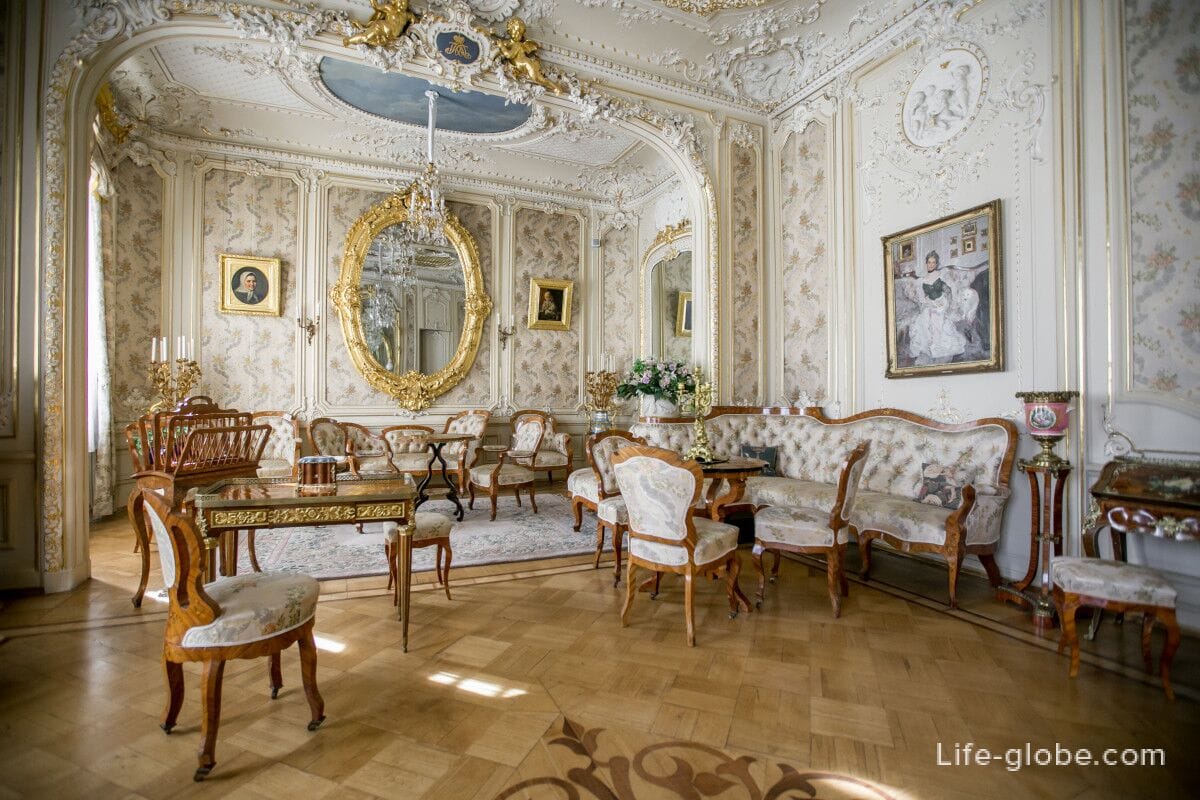
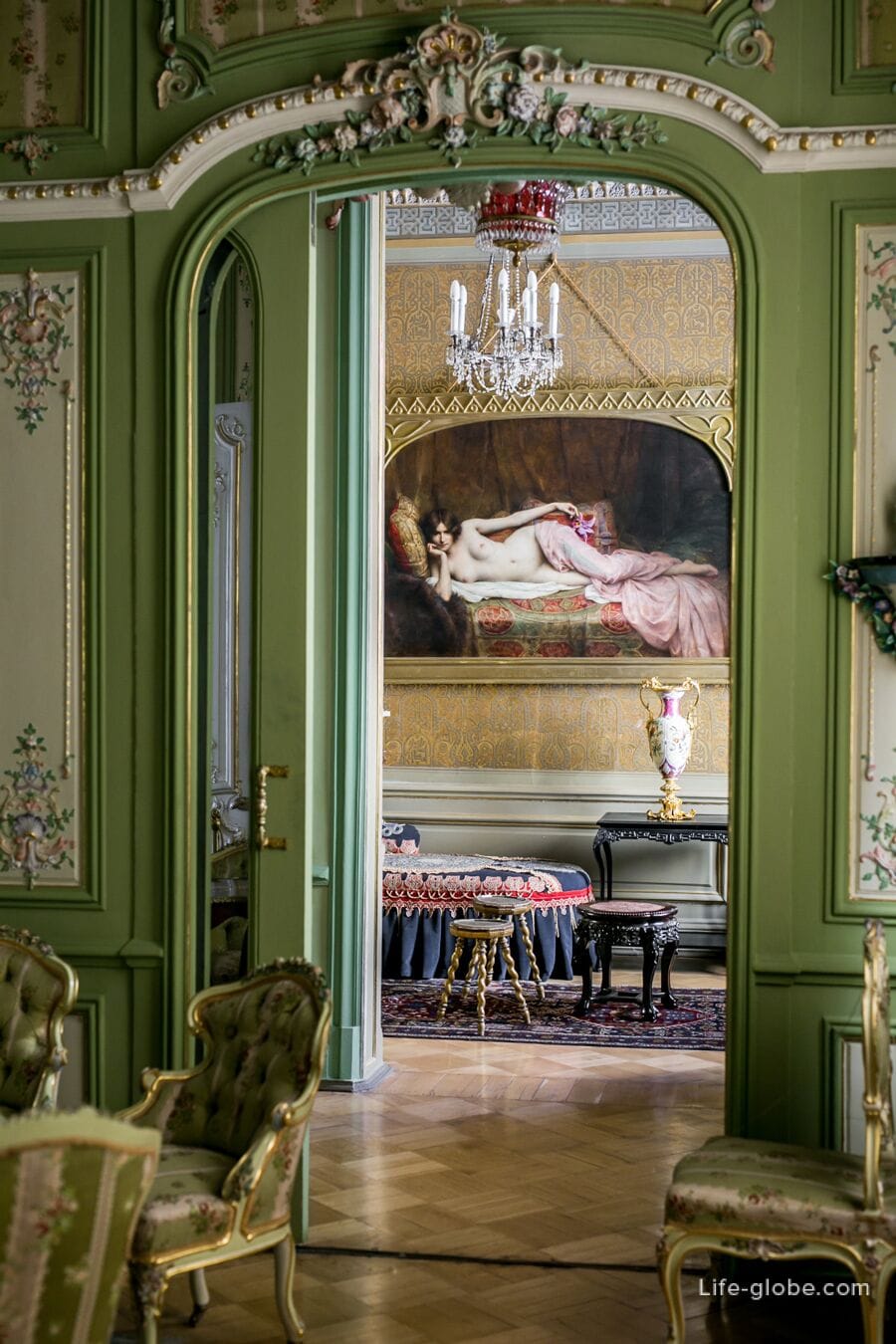
Half of the young
Half of the young people in the Yusupov Palace are historical interiors of the residential half of Prince Felix and Irina Yusupov, consisting of ceremonial and personal interiors created at the beginning of the 20th century.
The interiors of half of the young people are located on the ground floor of the palace and include: A small dance hall, a large living room, a unique Boudoir with a silver alcove, Irina's bedroom, a cave of jewels, Felix's study with a swimming pool.
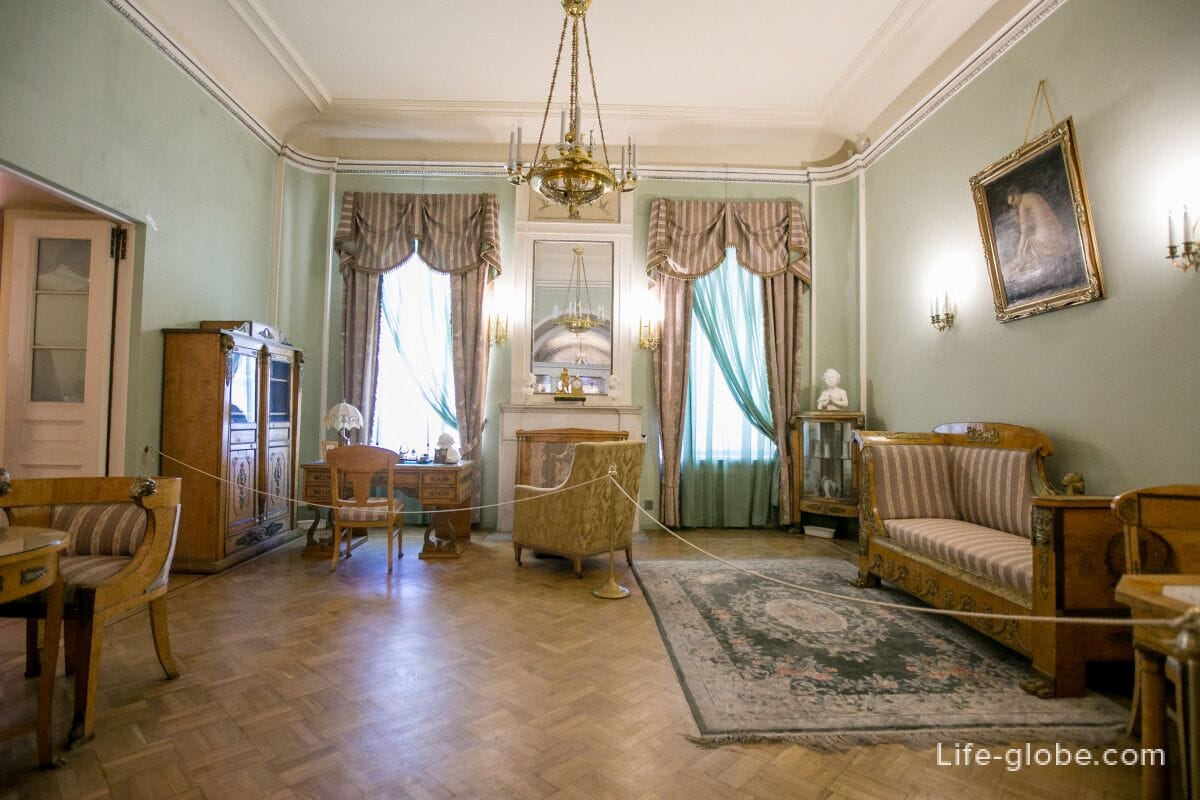
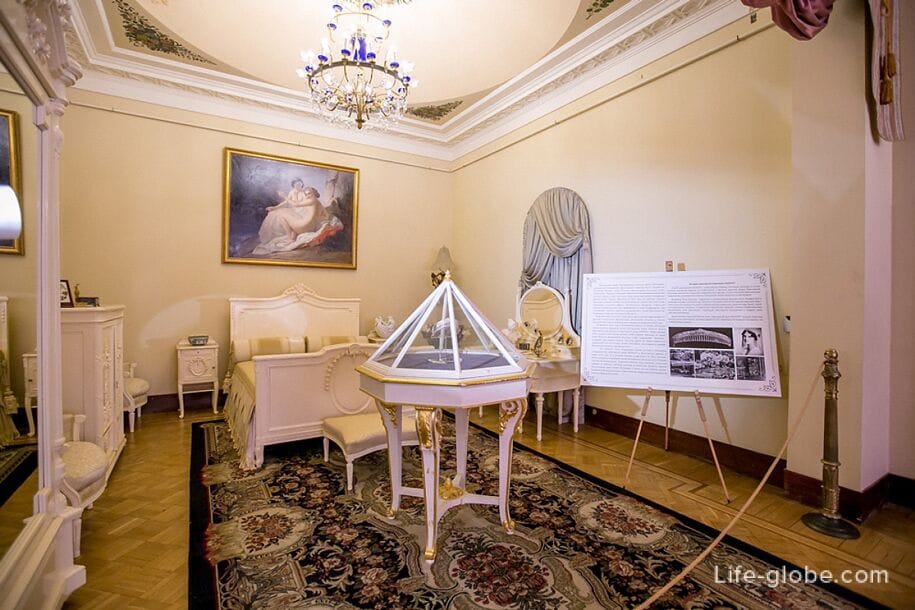
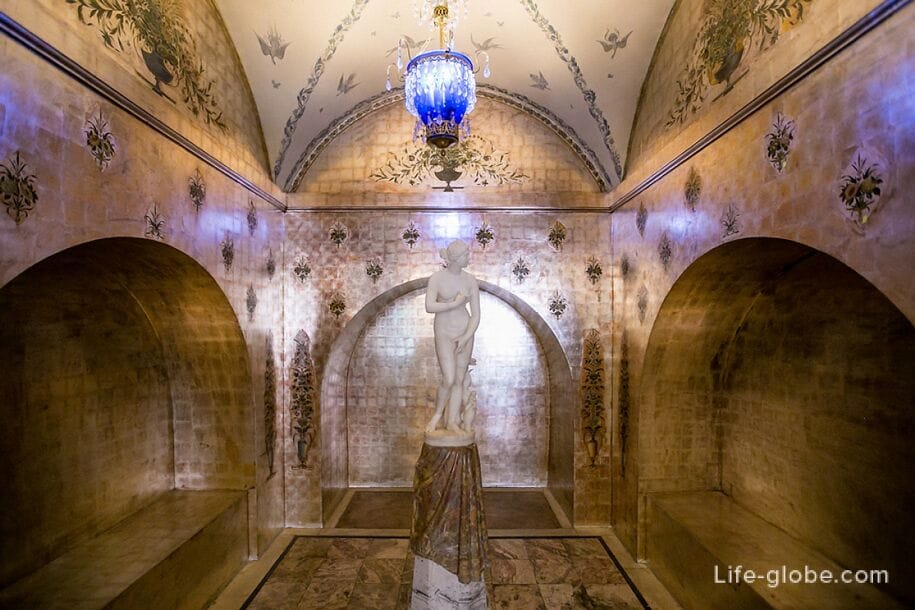
The exhibition "The Murder of G. Rasputin"
"... There were many quirks in these apartments, called the "garconiere", intended for possible visits of the prince during periods when the princess was absent and the state apartments were closed. There was a whole maze of small rooms with a spiral staircase descending into a dungeon that was supposed to serve as a Dining Room" - this is how architect Andrei Beloborodov recalled the interiors of the residential half of the young Felix Yusupov in the family princely palace.
It was here that on a December night in 1916, a plot was carried out to kill the "Siberian elder" Grigory Rasputin, the circumstances of whose death remain unclear to this day.
Today, in the recreated setting of the authentic interiors of the princely "garconiere" there is an exposition with wax figures of past events, photographs and documents shedding light on the personality of Grigory Rasputin and biography, as well as materials telling about the investigation of a high-profile murder, its consequences and versions.
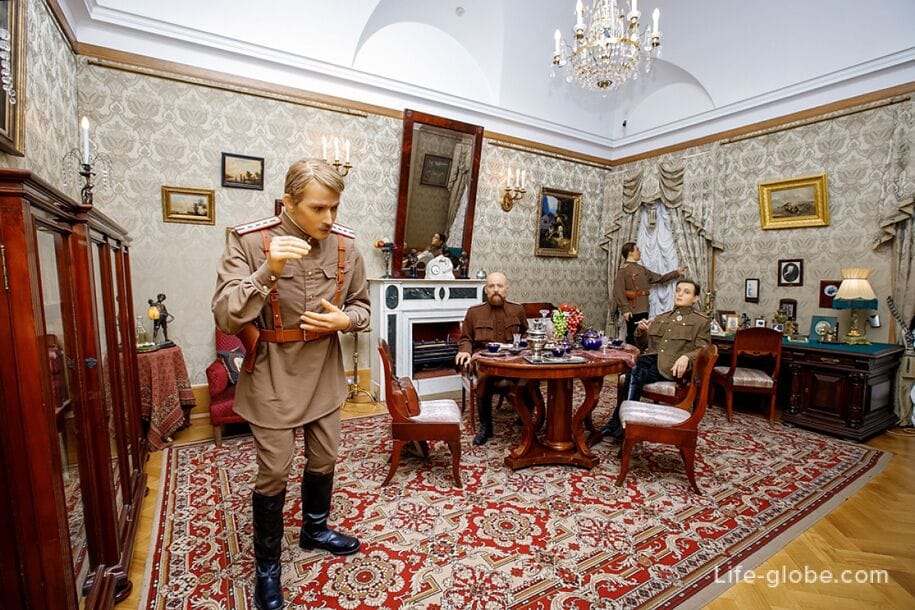
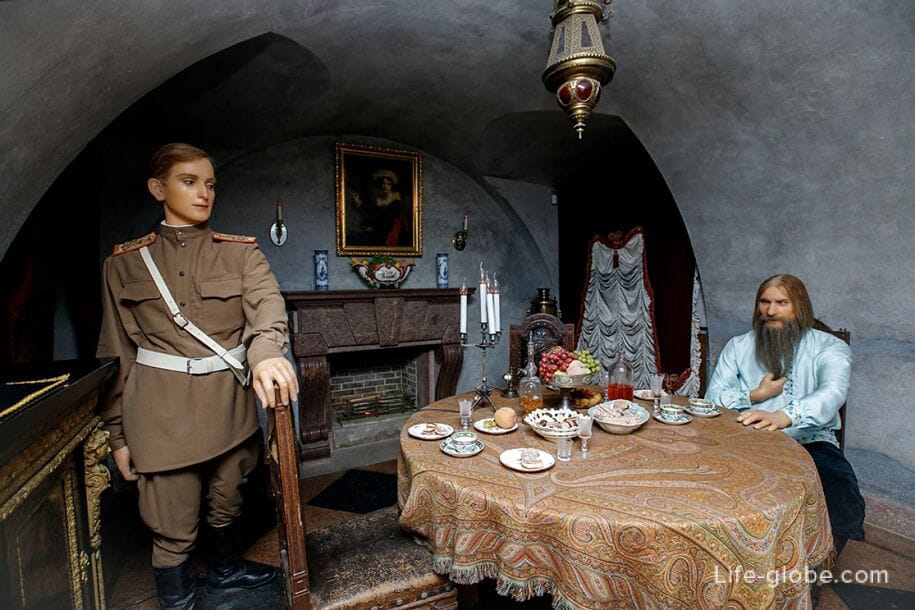
Remark! Half of the young and the Rasputin Murder exposition can be viewed as part of tours of the palace and when visiting the route "The Murder of G. Rasputin and Half of the Young", which is suitable for an individual self-visit with an audio guide or mobile application.
The scheme of the Yusupov Palace complex
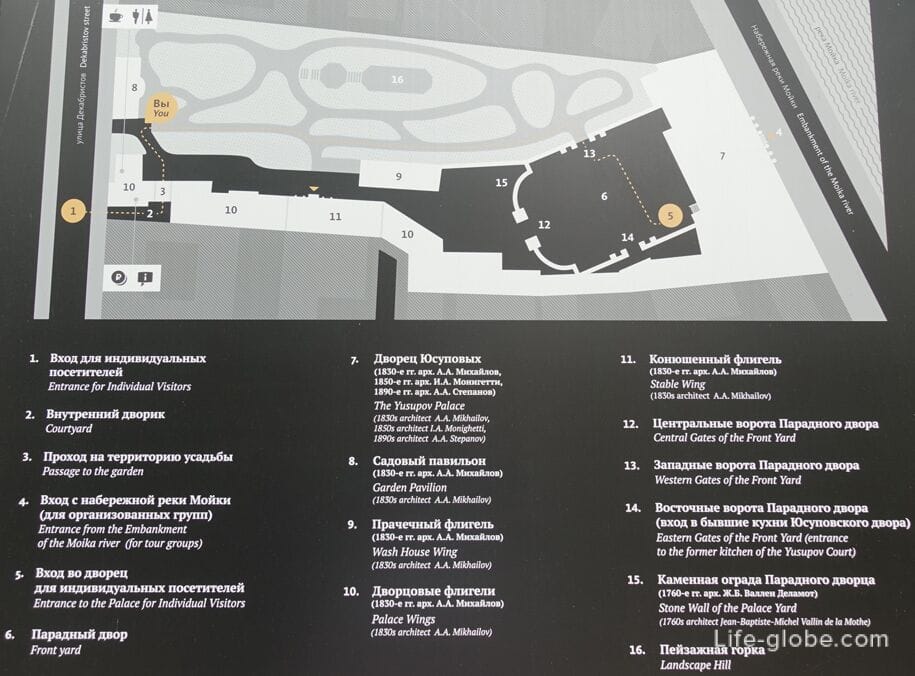
Practical information
A visit to the Yusupov Palace is paid.
You can take a walk in the palace garden for free.
Tickets for the routes around the palace can be purchased at the ticket offices or online in advance on the website of the Palace Museum.
In the palace, you can take an audio guide, which is issued on bail, or you can use a mobile phone application (Android or iOS).
Yusupov Palace website: yusupov-palace.
You can also visit the palace with a tour of St. Petersburg
Address of the Yusupov Palace: Moika River Embankment, 94 / Dekabristov Street, 21. Entrance for individual visitors from Dekabristov Street.
Coordinates of the Yusupov Palace: 59°55'45.0"N 30°17'56.0"E (59.929167, 30.298889).
You can get to the Yusupov Palace by taxi, car, public transport.
The nearest metro stations are Sennaya Ploshchad, Sadovaya, Spasskaya and Admiralteyskaya.
Buses: 3, 22, 27 (stop "Theater Square").
Trolleybuses: 5, 22 (stop "Palace of Labor").
All accommodation facilities in St. Petersburg, including in the city center and more remotely from it, can be viewed and booked here




